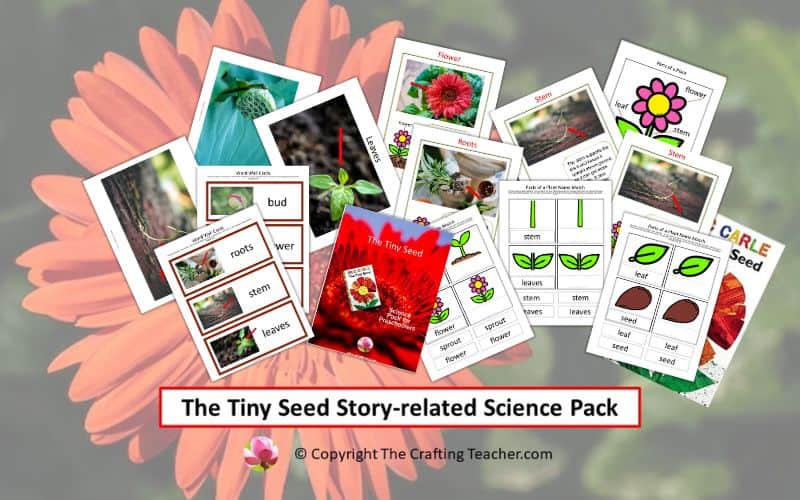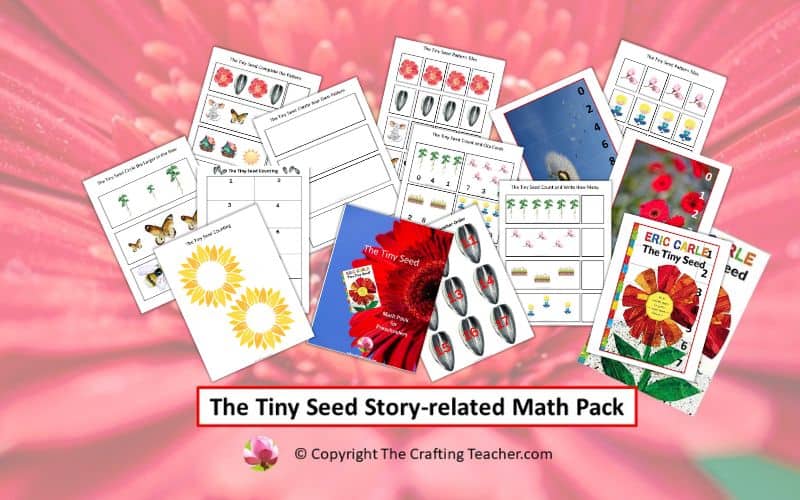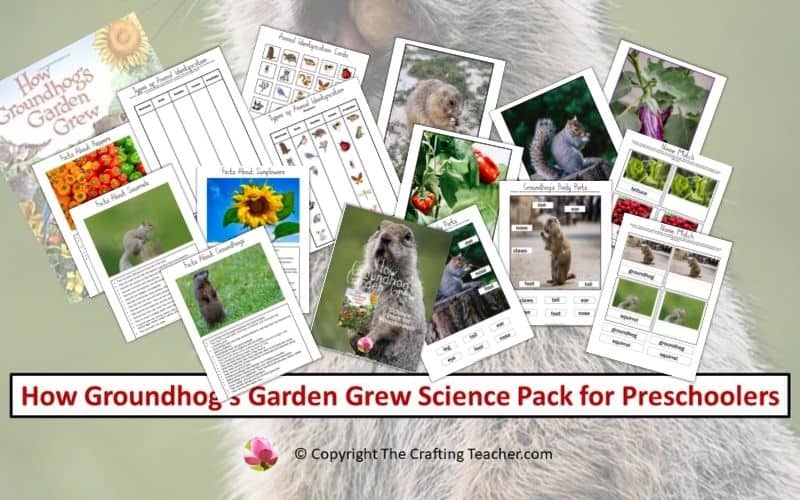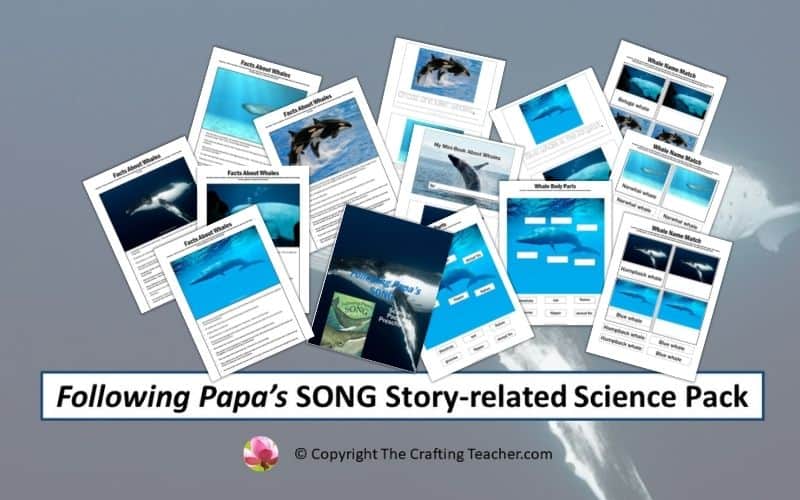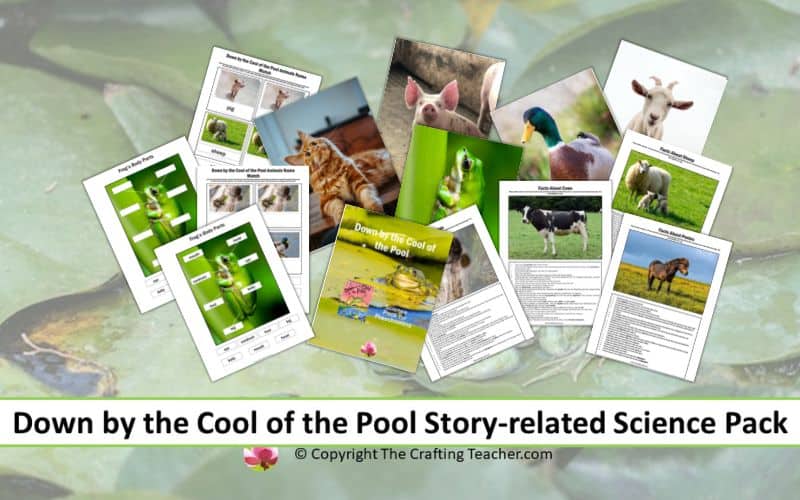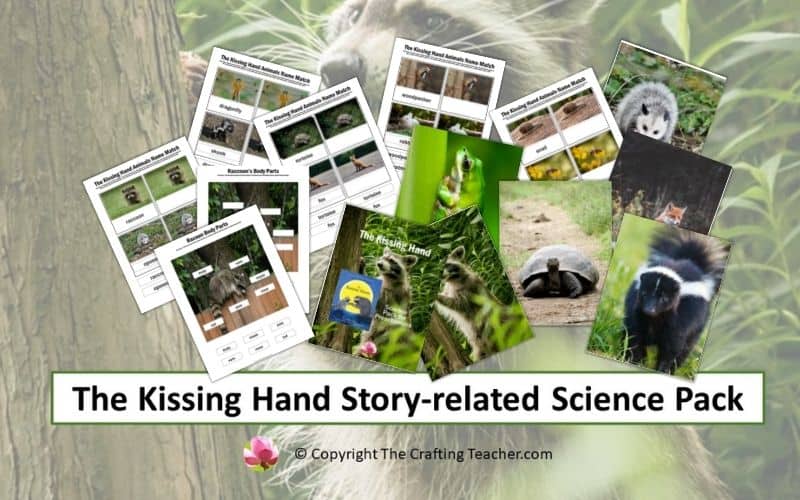The Tiny Seed Story-related Science Pack For Preschoolers
Affiliate Disclosure: “This post contains affiliate links, which means I receive a small commission, at no extra cost to you, if you make a purchase using those links.”
Children find the world around them fascinating, and they are constantly trying to find out why and how things happen, especially things from nature. This FREE 22-page long pack of The Tiny Seed Story-related Science Activities will help your preschoolers learn how a seed can transform into a plant.
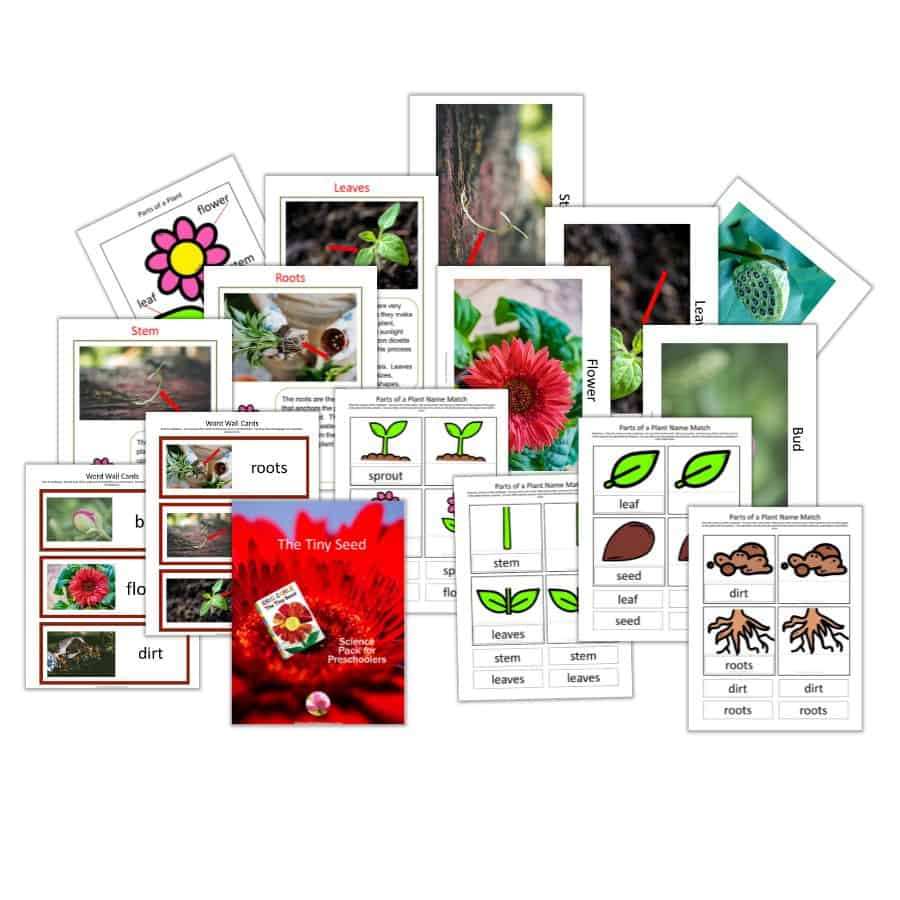
Introducing Science to Preschoolers
Science has always fascinated me, and it’s something that I share with preschoolers. Children are naturally curious about their world, so it’s very easy and a great idea to get them to engage in science activities at an early age. The secret is to do hands-on experiments with them, answer their questions and let them explore and experiment.
Benefits of Teaching Science to Preschoolers
Since children are always trying to make sense of what they perceive with their senses, we must take advantage of their natural curiosity and help them develop their scientific thinking.
Taking your time to introduce science to young children in a fun and interactive way, gives them many benefits. Some of them are:
- Use their interest in exploring and experimenting to establish a positive connection to science and encourage them to love it and stay interested for many years, if not thorough their entire life.
- Stimulate their scientific thinking, help them make sense of the world around them, and understand why things happen and how they work.
- Extend their vocabulary by promoting language development using scientific words, communication, teamwork and cooperation, reasoning, and problem-solving skills. You can use science to teach every domain because it can easily tie up to literacy, math, and art. Therefore, always encourage your children to ask questions, observe different types of natural phenomena, experiment, and explore, but, most importantly, give them plenty of opportunities to do just that by offering fun, interactive and hands-on experiences.
The Tiny Seed Science Activities
This beautiful book allows you to teach your preschoolers the process that seeds go throw when they are first released from the flower, and how they are going to transform when they land on fertile soil.
Discuss the Parts of a Plant
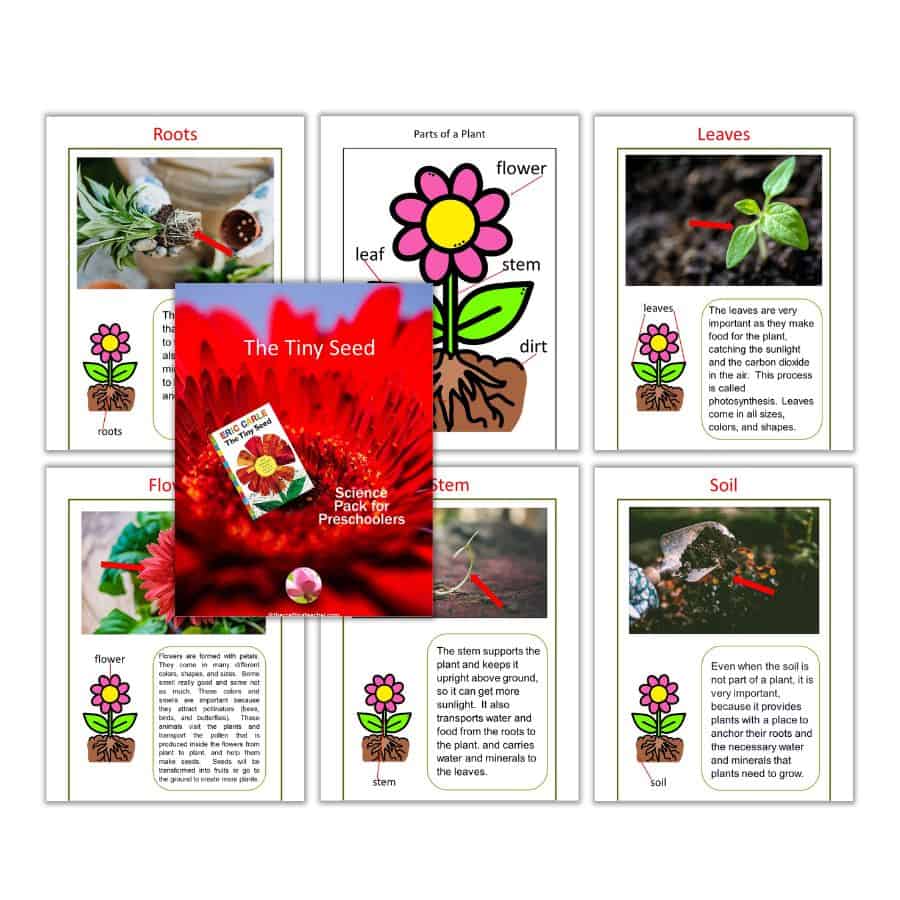
After reading The Tiny Seed with your children, use the Word Wall Cards, the poster of the parts of the plant, and the ones for each of its parts provided in the pack, to teach them which are the parts of a plant. The main parts are the roots, the leaves, the stem, and the flowers. Each part has an important role to keep the plant healthy.
The roots are the part that anchors the plant to the ground. They also absorb water and minerals from the soil, to keep the plant alive and healthy.
The leaves are very important as they make food for the plant, catching the sunlight and the carbon dioxide in the air. This process is called photosynthesis. Leaves come in all sizes, colors, and shapes.
The stem supports the plant and keeps it upright above ground, so it can get more sunlight. It also transports water and food from the roots to the plant. and carries water and minerals to the leaves.
Flowers are formed with petals. They come in many different colors, shapes, and sizes. Some smell good and some do not as much. These colors and smells are important because they attract pollinators (bees, birds, and butterflies). These animals visit the plants and transport the pollen that is produced inside the flowers from plant to plant, and help them make seeds. Seeds will be transformed into fruits or go to the ground to create more plants.
Even when the soil is not part of a plant, it is very important, because it provides plants with a place to anchor their roots and the necessary water and minerals that plants need to grow.
Parts of a Plant Name Match
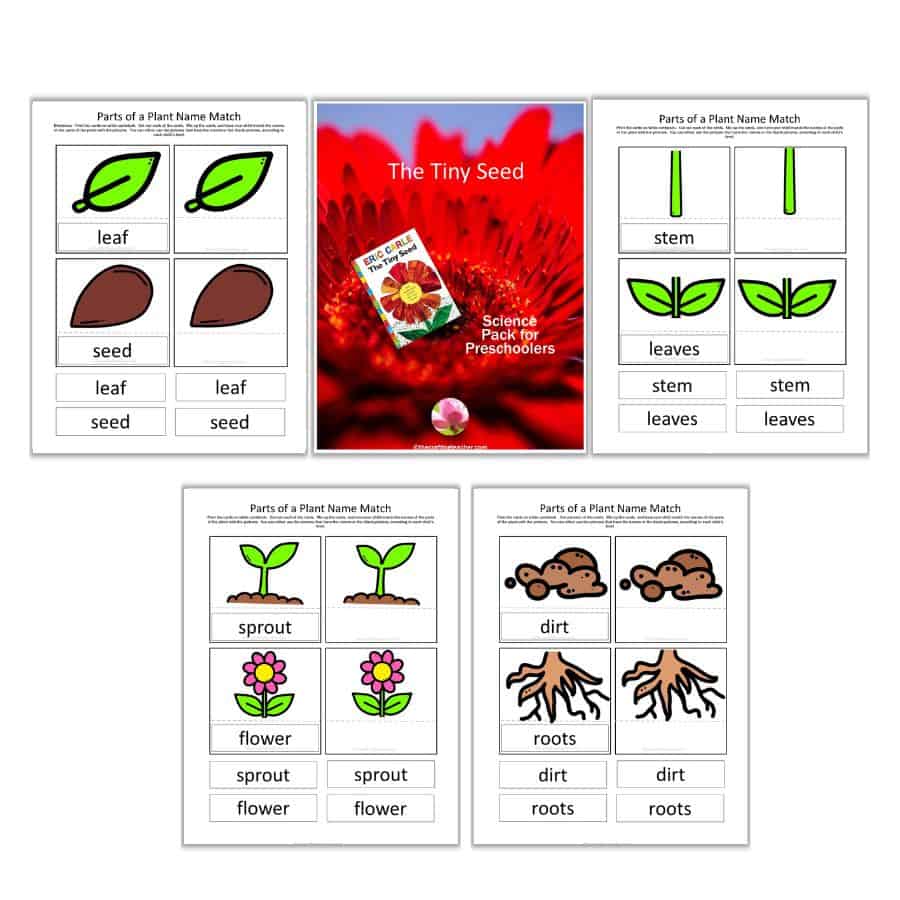
After you discuss the parts of a plant, you can invite your preschoolers to do the Parts of a Plant Name Match activity included in the pack. It is very easy to put it together. You just have to print the cards on white cardstock, cut them out, and laminate them for durability. Then, just mix up the cards, and have your children match the names of the parts of the plant with the pictures. You can either use the pictures that have the names or the blank pictures, according to each child’s level.
Discuss the Life Cycle of a Plant
After reading The Tiny Seed with your children, you can start discussing the life cycle of a plant. Maybe you can start by making a chart to find out what they know, such as a KWL chart, or maybe you would like to introduce the life cycle poster provided in the pack.
Talk to your children about what a seed needs to be able to grow, what are the steps in the life cycle of a plant and why some of the seeds didn’t grow in some of the places shown throughout The Tiny Seed story.
Planting Seeds Experiment
This is another great activity I love to do with my kiddos because they get to see the entire process of how a seed transforms to become a plant and then provides a product, but also teaches them first-hand how to take care of these plants.
To do this activity you just need a handful of materials:
- Sunflowers and lima beans seeds.
- magnifying glasses.
- paper towels.
- Ziploc bags.
- Small pots.
- Soil.
Allow students to observe a variety of different types of seeds with magnifying glasses. Ask them to talk about the different sizes and colors of the seed they are observing. Explain that they are all used to grow new plants. Ask the students if they have ever eaten a seed. Explain that not all seeds are editable, but some of them can be eaten by humans and animals. Provide sunflower seeds for them to try.
Explain that the seeds they are looking at are dormant, which means to be like sleep or inactive. When seeds are planted and receive the correct amount of sun and water, they will wake up and begin to germinate, which means they become active and sprout.
Explain to the students that they are going to germinate seeds. Divide the class into two groups:
The first group – Give each student of the first group a paper towel, Sunflower seeds, and a Ziploc bag where you previously wrote the name of the child and the type of seed. Have them moisten the paper towel, squeeze out the excess water, and place it inside the Ziploc bag. Lay the bag flat on a table, and have the children place their seeds in the middle.
Close the bag, and place it on a window, where they can receive light. Have them observe their bags every day to see if the seeds have germinated.
The second group – Give each child Lima seeds, soil, and a pot with the name of the child and the type of seeds. Have them place the soil in the pot, spread their seeds on top, and complete with a light layer of soil on top.
Have the lightly wet the soil, and place the pot on a windowsill. Have them observe their pots every day to see if the seeds have germinated.
Each day during circle time discuss which seeds have germinated and grow faster. Review what the seeds needed to germinate (light and water). Ask the students if they think the baby plants (seedlings) have everything they need to continue to grow into healthy plants. Explain that plants need light, water, light, fertilizers (nutrients), and air to grow and provide flowers, fruits, and vegetables.
Watch Videos
YouTube offers many educational videos about the parts of the plant and the germination process that you can watch with your preschoolers. These are some of them:
Discuss Similarities and Differences Among Seeds
Provide some trays with different types of seeds and magnifying glasses. Invite a small group of preschoolers at a time to observe the seeds, and discuss what they observe (colors, shapes, sizes, textures, etc.) Have them predict which seeds might grow faster, and what type of flower, herb, or vegetable might grow from it. Take dictation on a poster board about their comments.
Select a space in your garden or a pot for each group of children, and have them plant their seeds. Have each group of children observe their plants as they grow, talk about the changes they are noticing, and compare their observations with their predictions.
Investigate Which Types of Food Have Seeds
During circle time bring in a basket with familiar foods and ask the children to predict which food item they think has seeds. Allow them to pick items from the basket and tell the class why they think the items they picked up have seeds.
Allow the rest of the children to agree or not with the statement each child presents, and why. Write their opinions on a chart paper. This activity will allow you to access each child’s knowledge.
Once each child selected an item from the basket and the group finished their explanations and discussion, have the children open each of their items and find out if their predictions were correct.
Pretend to Be Seeds
Ask your students to pretend they are a dormant seed in the soil. Play instrumental music and tell them that it is spring, the sun is warm, and rain showers have moist the soil, allowing them to germinate. Ask your preschoolers to pretend they are germinating seeds and becoming little plants (seedlings), to the tune of instrumental music.
Sensory Table
Present your sensory table with small pots, soil, seeds, plastic flowers and vegetables, small gardening tools, and any other object you think might be appropriate, and let them exercise their senses and observation abilities.
Art
There are some activities that come to mind for them to do after you read The Tiny Seed story or discuss the similarities and differences among the seeds you provide, such as:
- Invite your preschoolers to use tempera paint, crayons, and/or markers to paint or draw their favorite scene in the book The Tiny Seed, and take dictation of what they tell you about their drawings.
- Provide a bowl with different types of seeds, glue, and construction paper, and have them make collages with their seeds.
Extra Activities
- Invite a gardener to come to the class and talk about plants, and how to take care of them.
- Start your own garden using the seedlings that the children started.
Related Books
As usual, I like to include books in all my activities. These are some of the most interesting books you can find at your local library, used books store, and on Amazon. If you want fast access, just click on the pictures and my links will take you directly to the book on Amazon.








You can use these ideas by themselves, but I will invite you to combine them with the free literacy and math activity packs I created for this beautiful story, The Tiny Seed, to take advantage of the opportunity this book offers. Remember that for a more comprehensive and complete educational process, you should not divorce literacy from math, science, or any other domain. They intermingle together and complement each other.
Pin It For Later
If you are in a rush and don’t have time to read the post and download the printable but want to save it for later, pin this to your science or another board on Pinterest for later.
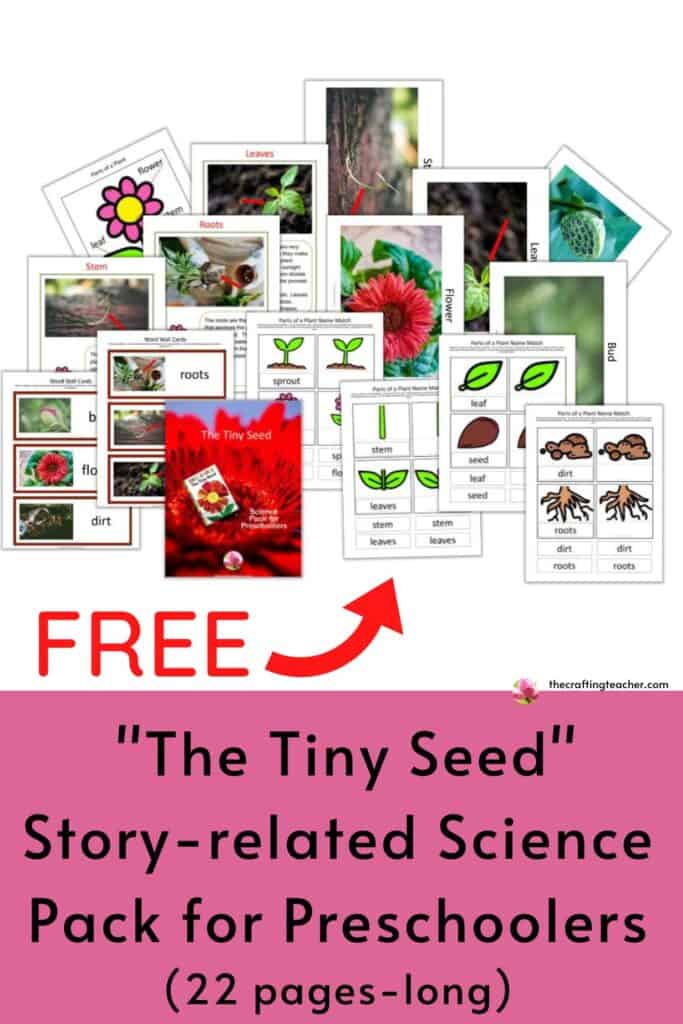
Don’t forget to download your FREE The Tiny Seed Science activities pack. You just have to click on the link below and type your email, for an immediate download.
Be happy, safe, and creative. I wish you well.
Love,

P.S. Please let me know if try some of the suggested activities, and how they worked out for you and your children.
Other Posts You Might Like:
My Amazon Picks:

